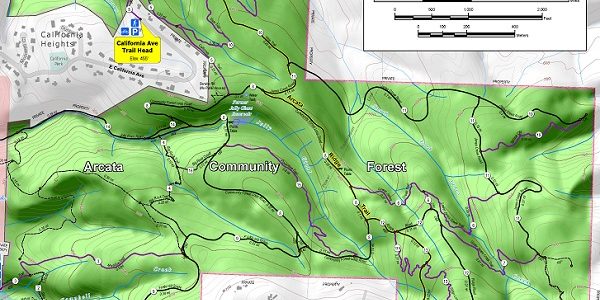City of Arcata Community Forest

City of Arcata Community Forest
Written by Mark Andre and Michael McDowall
The City of Arcata Community Forest, encompassing 2,400 acres of coastal redwood and Douglas-fir on the northern coast of California, is the newest Forest Stewards Guild Model Forest. The operation of Arcata’s Community Forest as a whole is tied to forest management plans stemming from a 1979 voter-approved initiative to manage the forest using “ecological principles” with a portion of the net revenue to be used for parkland acquisition. Generally, the forest management goals are four tiered:
- Maintain the health of the forest system. Specifically maintain the integrity of the watershed, wildlife, fisheries, and plant resources, their relationships, and the processes through which they interact with their environment.
- Produce marketable forest products and income to the city in perpetuity, balancing timber harvest and growth.
- Provide forest recreation opportunities for the community.
- Serve as a model of managed redwood forests for demonstration purposes.
The Arcata Community Forest was the first municipal forest certified in the U.S. under the Forest Stewardship Council. As the owner of less than 2,500 acres of timberland, Arcata was able to file a non-industrial timber management plan for the community forest.
This means that the city’s forester does not have to prepare a timber harvesting plan for each new logging operation and can thereby choose the optimal time to harvest, e.g. when wood prices are high. About 300,000-500,000 board feet are harvested on an annualized basis from the forest. Its estimated growth is about 2.5 percent per year, and the annual cut level is about one percent per year. The forester’s objective is for each harvest rotation to exceed 100 years, ideal for production of high-quality redwood lumber. 1
Arcata’s forest management enhances the entire forest ecosystem in a variety of ways, including:
- long-term protection of sensitive creek and riparian zones,
- protection of habitat for various sensitive and/or endangered species,
- carbon sequestration, and
- preventing conversion of timber production zones into residential housing.
Forest management also addresses a diverse field of biological ecosystem functions.
- No old growth is cut,
- no pesticides or herbicides are used,
- no winter logging is allowed, and
- no new roads or skid trails are built.
The setbacks, or “no-cut” zones, along all classes of streams, as well as around springs and seeps, are among the most stringent in California. Individual or small groups of trees are logged to allow a mixture of shade and sun-loving species to regenerate. The management philosophy is to create conditions that resemble a late-seral stage forest. The reproductive success of two resident pairs of northern spotted owls is one of the indications that the forest plan is succeeding.
Wildlife habitat opportunities often shape the way timber silviculture is prescribed. In addition, rare and sensitive plant species are promoted through presence or absence surveys in coordination with a variety of protection techniques. Fish and other aquatic species are also a main priority in managing Arcata’s forest. Salmonid streams have been identified. By working with other local agencies such as California Fish and Game and U.S. Fish and Wildlife, these salmonid streams are constantly being enhanced and repaired from legacy losses or degradation of habitats.
The team of three Guild professional members who conducted the field review (a requirement for Model Forest designation) noted, "The Arcata Community Forest is a superb example of a working, multiple-use community forest in the coastal Redwood/Douglas-fir belt of California and will be a fine addition to the Model Forest Program.”
The City of Arcata is proud to be part of the Forest Stewards Guild’s Model Forest program.
1 Excerpted from Coast Redwood: A Natural and Cultural History. Cachuma Press, Los Olivos, CA. (c) 2001.
Photo credits: The City of Arcata and Michael McDowall.
Forest Statistics
- Acreage: 2,400
- Forest Type:
- coastal redwood
- Douglas fir
- Manager: Mark Andre, City of Arcata Environmental Services Dept.
- Primary Uses: watershed protection, recreation, timber, wildlife
- Certifications:
- Forest Stewardship Council
- Model Forest Letter of Designation
Documents and maps
- A video (6 mins)
- Slideshow (PDF)
- Acquiring and Managing A Community-Owned Forest: A Manual for Communities (PDF).
- Complete Forest Management Plan (1994, PDF)
- Arcata Forest Non-Industrial Timber Management Plan (2000, PDF)
- Jacoby Creek Watershed and Habitat map (PDF)
- Jacoby Creek Forest map (PDF)
- Redwood Forest Bird Checklist (PDF)
- More information at City of Arcata
Stay Informed
about our recent projects and upcoming events.
